Share this
What Is a Blade Server? [With PDF]
by Brett Daniel on Jun 12, 2020 4:23:58 PM
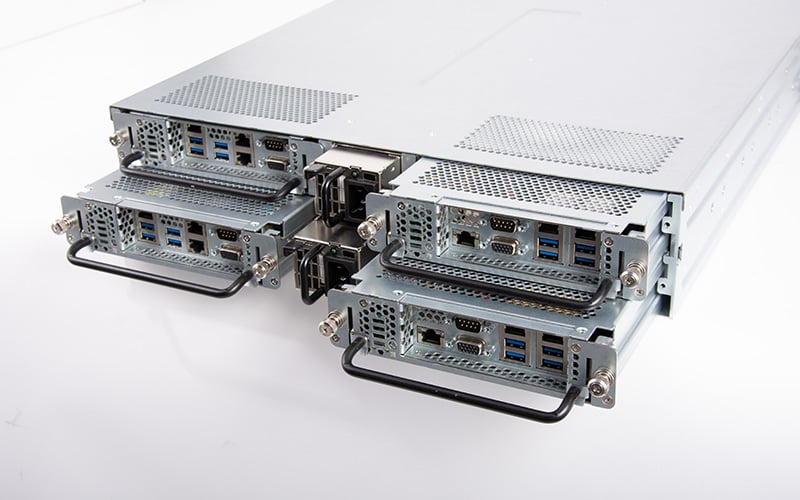
Photo: A 2U rugged blade server with four 1U server blades
In previous blog posts, we've discussed the different types of rugged servers, including the common rack server.
We've only ever briefly touched on blade servers, however, and they're a crucial part of many data centers and programs supporting resource-intensive applications.
Despite their compactness, blade servers pack quite a punch, and they can offer outstanding performance to your application.
Whether you're looking to boost processing power, save space, reduce power consumption or implement a computer system that's easily replaceable and repairable, the blade server has your back.

Photo: At left, a 2U server blade, alongside two 1U server blades
What is a blade server?
A blade server is a thin, lightweight, modular computer that slides in and out of a rack called a blade enclosure.
A blade server is part of the rack mount computer family alongside its big brother, the formidable rack server.
A blade server is typically situated inside a blade enclosure alongside other blade servers. This full assemblage of blade servers, called a blade system, is usually rack mounted, just like its rack mount server counterpart.
Blade servers are typically located inside massive cloud data centers, storing data and performing high-performance computation for resource-intensive applications.
And their durable brethren, the rugged blade servers, are hardened, stress-tested machines that can be found supporting military and industrial applications in extreme conditions worldwide.
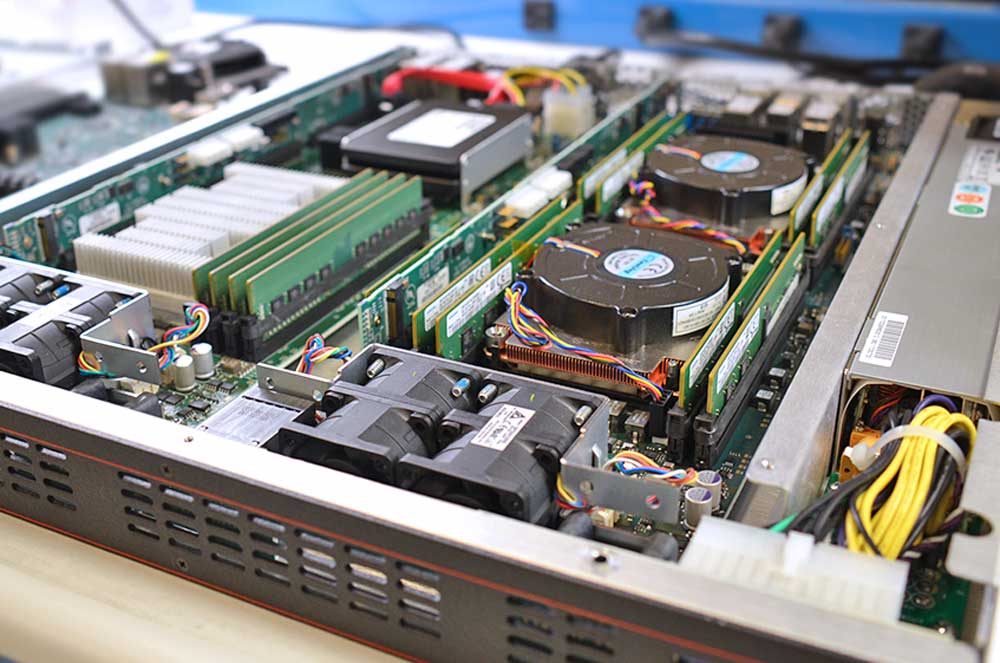
Photo: An inside look at a 1U blade computer
How do blade servers work?
Blade servers are uniquely designed for programs looking to save space, conserve energy, decrease mean time to repair (MTTR) and maximize processing power.
Due to their naturally small size, they're usually only offered in a 1U or 2U blade server configuration. The number of blade servers in a 1U or 2U chassis will depend on the requirements of a customer's specific program or application.
At Trenton Systems, we can fit up to two 1U server blades into a 1U modular blade chassis, up to four 1U server blades into a 2U chassis or up to two 2U server blades into a 2U chassis.
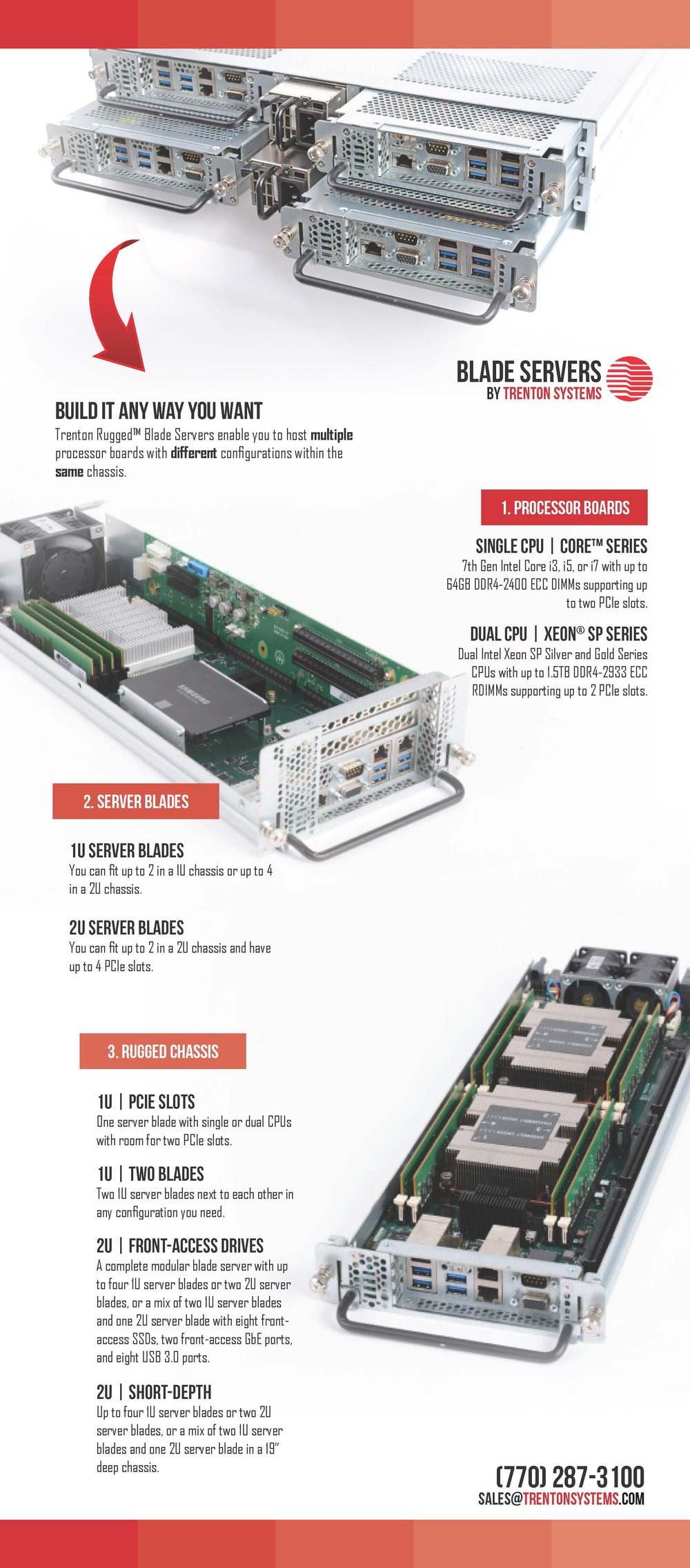
The slidable, hot-swappable nature of blade servers makes them easy to inspect, replace, or repair, all while the other blade servers in the enclosure continue to function seamlessly.
In addition, blade servers are capable of utilizing the same high-speed processors as their rack server and workstation counterparts, making for one heck of a processing powerhouse when coupled together in a blade system.
Trenton Systems' blade servers allow for the incorporation of multiple single or dual CPU processor boards supporting Intel Core i3, i5 or i7 or Dual Xeon SP processors.
For example, our MBS1001 modular blade chassis can support two 1U server blades, each with a Dual Xeon SP CPU, for a total of four CPUs. Conversely, our 2U chassis can support up to four 1U server blades, or eight CPUs.
That's a lot of processing power for such a small server.
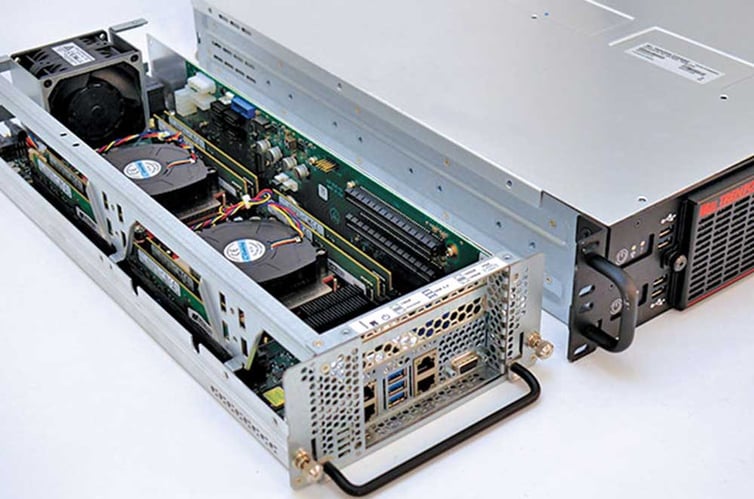
Photo: A 2U blade computer situated next to a 2U modular chassis. Note the two PCIe slots installed on the riser card.
Which expansion slots are found in blade servers?
Despite their small size, modular servers can still incorporate expansion slots via riser cards.
PCIe slots are frequently found in blade servers today, but you'll still see PCI-X slots appear from time to time.
Depending on the blade server configuration, you can achieve up to four PCIe Gen 3 slots with Trenton Systems' blade servers, or even more than that with the incorporation of a PCIe expansion kit and backplane.
For example, we have a 1U blade server configuration that supports up to two PCIe Gen 3 slots, but if your application needs more, we also have a 2U blade server configuration that supports up to four.
In other words, you don't have to sacrifice expandability simply because you're using a modular server.
You'll still have the option of adding any necessary high-speed components down the line.
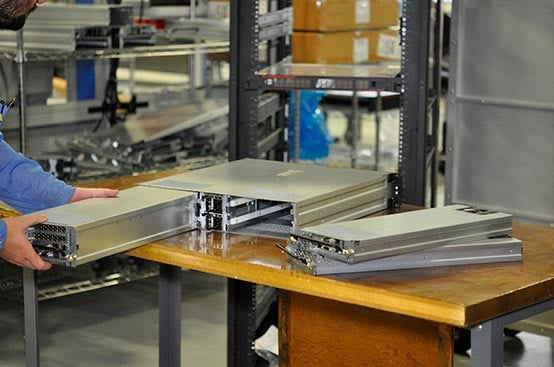
Photo: An in-house demonstration of how a 2U blade computer slides into a 2U modular blade chassis
What is a blade server used for?
Programs that emphasize space conservation and reduction in power consumption but still require a high-performance server will find the blade server quite useful.
Their thin, compartmentalized form factor makes them inherently more scalable than a rack server. In addition, because one, chassis-supported power supply unit can power all the server blades within an enclosure, blade servers are naturally more energy-efficient.
Furthermore, blade servers' compute density is unmatched, which is often why you see them powering resource-intensive applications.
For example, with a 1U rack mount server, you might be able to incorporate two Dual Xeon SP CPU processor boards, for a total of four CPUs, only, but picture a blade enclosure housing numerous blade servers, each with a Dual Xeon SP CPU, and just think of how much processing power you can achieve.
Conclusion
Just like the rack server, blade servers can be used to:
- Boost the computational capabilities of your program or application
- Conserve or maximize available space
- Reduce power costs in the long-term
- Implement a server system that's both easily replaceable and repairable, without sacrificing the necessary continuity of mission-critical applications
If these perks and benefits sound ideal, then the blade server just might be for you.
Need more information on whether a blade server is right for you?
You can also check out 3 Reasons You Should Consider Upgrading to a Blade Server.
Share this
- High-performance computers (42)
- Military computers (38)
- Rugged computers (32)
- Cybersecurity (25)
- Industrial computers (25)
- Military servers (24)
- MIL-SPEC (20)
- Rugged servers (19)
- Press Release (17)
- Industrial servers (16)
- MIL-STD-810 (16)
- 5G Technology (14)
- Intel (13)
- Rack mount servers (12)
- processing (12)
- Computer hardware (11)
- Edge computing (11)
- Rugged workstations (11)
- Made in USA (10)
- Partnerships (9)
- Rugged computing (9)
- Sales, Marketing, and Business Development (9)
- Trenton Systems (9)
- networking (9)
- Peripheral Component Interconnect Express (PCIe) (7)
- Encryption (6)
- Federal Information Processing Standards (FIPS) (6)
- GPUs (6)
- IPU (6)
- Joint All-Domain Command and Control (JADC2) (6)
- Server motherboards (6)
- artificial intelligence (6)
- Computer stress tests (5)
- Cross domain solutions (5)
- Mission-critical servers (5)
- Rugged mini PCs (5)
- AI (4)
- BIOS (4)
- CPU (4)
- Defense (4)
- Military primes (4)
- Mission-critical systems (4)
- Platform Firmware Resilience (PFR) (4)
- Rugged blade servers (4)
- containerization (4)
- data protection (4)
- virtualization (4)
- Counterfeit electronic parts (3)
- DO-160 (3)
- Edge servers (3)
- Firmware (3)
- HPC (3)
- Just a Bunch of Disks (JBOD) (3)
- Leadership (3)
- Navy (3)
- O-RAN (3)
- RAID (3)
- RAM (3)
- Revision control (3)
- Ruggedization (3)
- SATCOM (3)
- Storage servers (3)
- Supply chain (3)
- Tactical Advanced Computer (TAC) (3)
- Wide-temp computers (3)
- computers made in the USA (3)
- data transfer (3)
- deep learning (3)
- embedded computers (3)
- embedded systems (3)
- firmware security (3)
- machine learning (3)
- Automatic test equipment (ATE) (2)
- C6ISR (2)
- COTS (2)
- COVID-19 (2)
- CPUs (2)
- Compliance (2)
- Compute Express Link (CXL) (2)
- Computer networking (2)
- Controlled Unclassified Information (CUI) (2)
- DDR (2)
- DDR4 (2)
- DPU (2)
- Dual CPU motherboards (2)
- EW (2)
- I/O (2)
- Military standards (2)
- NVIDIA (2)
- NVMe SSDs (2)
- PCIe (2)
- PCIe 4.0 (2)
- PCIe 5.0 (2)
- RAN (2)
- SIGINT (2)
- SWaP-C (2)
- Software Guard Extensions (SGX) (2)
- Submarines (2)
- Supply chain security (2)
- TAA compliance (2)
- airborne (2)
- as9100d (2)
- chassis (2)
- data diode (2)
- end-to-end solution (2)
- hardware security (2)
- hardware virtualization (2)
- integrated combat system (2)
- manufacturing reps (2)
- memory (2)
- mission computers (2)
- private 5G (2)
- protection (2)
- secure by design (2)
- small form factor (2)
- software security (2)
- vRAN (2)
- zero trust (2)
- zero trust architecture (2)
- 3U BAM Server (1)
- 4G (1)
- 4U (1)
- 5G Frequencies (1)
- 5G Frequency Bands (1)
- AI/ML/DL (1)
- Access CDS (1)
- Aegis Combat System (1)
- Armed Forces (1)
- Asymmetric encryption (1)
- C-RAN (1)
- COMINT (1)
- Cloud-based CDS (1)
- Coast Guard (1)
- Compliance testing (1)
- Computer life cycle (1)
- Containers (1)
- D-RAN (1)
- DART (1)
- DDR5 (1)
- DMEA (1)
- Data Center Modular Hardware System (DC-MHS) (1)
- Data Plane Development Kit (DPDK) (1)
- Defense Advanced Research Projects (DARP) (1)
- ELINT (1)
- EMI (1)
- EO/IR (1)
- Electromagnetic Interference (1)
- Electronic Warfare (EW) (1)
- FIPS 140-2 (1)
- FIPS 140-3 (1)
- Field Programmable Gate Array (FPGA) (1)
- Ground Control Stations (GCS) (1)
- Hardware-based CDS (1)
- Hybrid CDS (1)
- IES.5G (1)
- ION Mini PC (1)
- IP Ratings (1)
- IPMI (1)
- Industrial Internet of Things (IIoT) (1)
- Industry news (1)
- Integrated Base Defense (IBD) (1)
- LAN ports (1)
- LTE (1)
- Life cycle management (1)
- Lockheed Martin (1)
- MIL-S-901 (1)
- MIL-STD-167-1 (1)
- MIL-STD-461 (1)
- MIL-STD-464 (1)
- MOSA (1)
- Multi-Access Edge Computing (1)
- NASA (1)
- NIC (1)
- NIC Card (1)
- NVMe (1)
- O-RAN compliant (1)
- Oil and Gas (1)
- Open Compute Project (OCP) (1)
- OpenRAN (1)
- P4 (1)
- PCIe card (1)
- PCIe lane (1)
- PCIe slot (1)
- Precision timestamping (1)
- Product life cycle (1)
- ROM (1)
- Raytheon (1)
- Remotely piloted aircraft (RPA) (1)
- Rugged computing glossary (1)
- SEDs (1)
- SIM Card (1)
- Secure boot (1)
- Sensor Open Systems Architecture (SOSA) (1)
- Small form-factor pluggable (SFP) (1)
- Smart Edge (1)
- Smart NIC (1)
- SmartNIC (1)
- Software-based CDS (1)
- Symmetric encryption (1)
- System hardening (1)
- System hardening best practices (1)
- TME (1)
- Tech Partners (1)
- Total Memory Encryption (TME) (1)
- Transfer CDS (1)
- USB ports (1)
- VMEbus International Trade Association (VITA) (1)
- Vertical Lift Consortium (VLC) (1)
- Virtual machines (1)
- What are embedded systems? (1)
- Wired access backhaul (1)
- Wireless access backhaul (1)
- accredidation (1)
- aerospace (1)
- air gaps (1)
- airborne computers (1)
- asteroid (1)
- authentication (1)
- autonomous (1)
- certification (1)
- cognitive software-defined radios (CDRS) (1)
- command and control (C2) (1)
- communications (1)
- cores (1)
- custom (1)
- customer service (1)
- customer support (1)
- data linking (1)
- data recording (1)
- ethernet (1)
- full disk encryption (1)
- hardware monitoring (1)
- heat sink (1)
- hypervisor (1)
- in-house technical support (1)
- input (1)
- integrated edge solution (1)
- international business (1)
- licensed spectrum (1)
- liquid cooling (1)
- mCOTS (1)
- microelectronics (1)
- missile defense (1)
- mixed criticality (1)
- moving (1)
- multi-factor authentication (1)
- network slicing (1)
- neural networks (1)
- new headquarters (1)
- next generation interceptor (1)
- non-volatile memory (1)
- operating system (1)
- output (1)
- outsourced technical support (1)
- post-boot (1)
- pre-boot (1)
- private networks (1)
- public networks (1)
- radio access network (RAN) (1)
- reconnaissance (1)
- rugged memory (1)
- secure flash (1)
- security (1)
- self-encrypting drives (SEDs) (1)
- sff (1)
- software (1)
- software-defined radios (SDRs) (1)
- speeds and feeds (1)
- standalone (1)
- storage (1)
- systems (1)
- tactical wide area networks (1)
- technical support (1)
- technology (1)
- third-party motherboards (1)
- troposcatter communication (1)
- unlicensed spectrum (1)
- volatile memory (1)
- vpx (1)
- zero trust network (1)
- January 2025 (1)
- November 2024 (1)
- October 2024 (1)
- August 2024 (1)
- July 2024 (1)
- May 2024 (1)
- April 2024 (3)
- February 2024 (1)
- November 2023 (1)
- October 2023 (1)
- July 2023 (1)
- June 2023 (3)
- May 2023 (7)
- April 2023 (5)
- March 2023 (7)
- December 2022 (2)
- November 2022 (6)
- October 2022 (7)
- September 2022 (8)
- August 2022 (3)
- July 2022 (4)
- June 2022 (13)
- May 2022 (10)
- April 2022 (4)
- March 2022 (11)
- February 2022 (4)
- January 2022 (4)
- December 2021 (1)
- November 2021 (4)
- September 2021 (2)
- August 2021 (1)
- July 2021 (2)
- June 2021 (3)
- May 2021 (4)
- April 2021 (3)
- March 2021 (3)
- February 2021 (8)
- January 2021 (4)
- December 2020 (5)
- November 2020 (5)
- October 2020 (4)
- September 2020 (4)
- August 2020 (6)
- July 2020 (9)
- June 2020 (11)
- May 2020 (13)
- April 2020 (8)
- February 2020 (1)
- January 2020 (1)
- October 2019 (1)
- August 2019 (2)
- July 2019 (2)
- March 2019 (1)
- January 2019 (2)
- December 2018 (1)
- November 2018 (2)
- October 2018 (5)
- September 2018 (3)
- July 2018 (1)
- April 2018 (2)
- March 2018 (1)
- February 2018 (9)
- January 2018 (27)
- December 2017 (1)
- November 2017 (2)
- October 2017 (3)
/Trenton%20Systems%20Circular%20Logo-3.png?width=50&height=50&name=Trenton%20Systems%20Circular%20Logo-3.png)


No Comments Yet
Let us know what you think